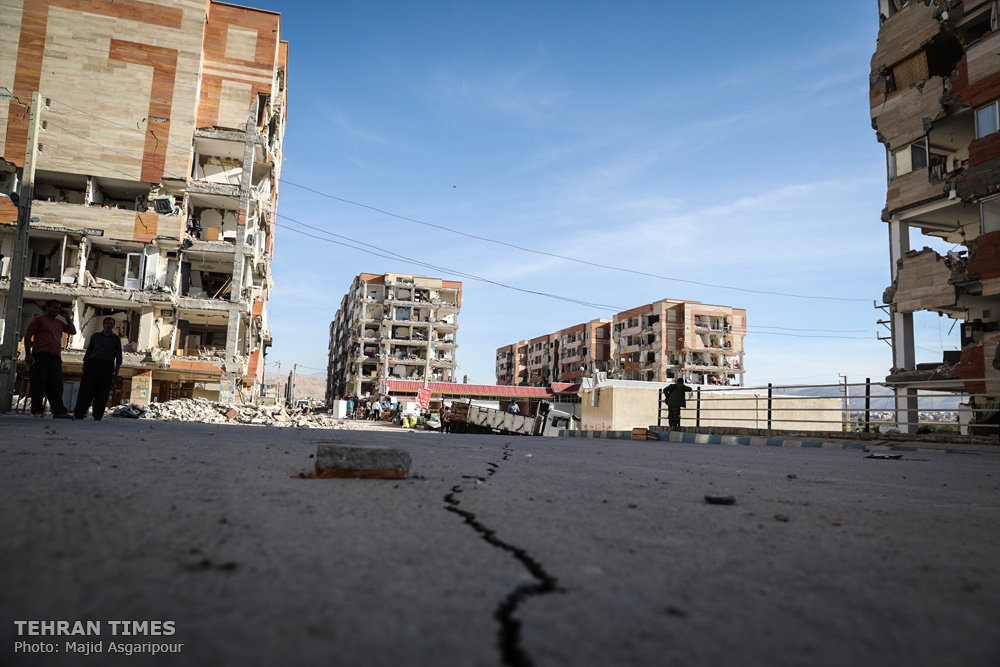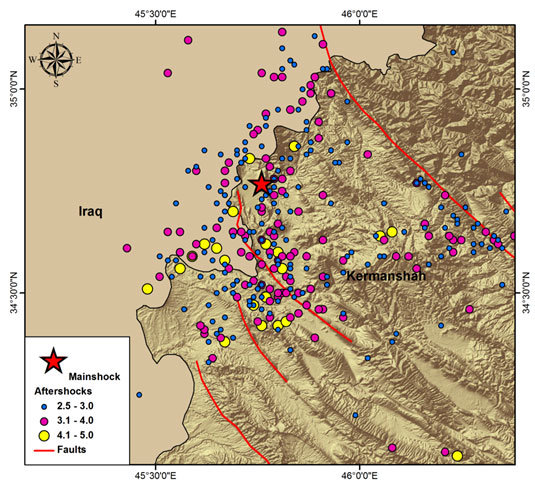7.3 magnitude quake in Sarepol-e Zahab

On November 12, 2017, at 18:18 UTC (21:48 Iran Standard Time), a major earthquake with the moment magnitude of 7.3 occurred in Kermanshah province, western Iran.
According to the National Center of Broadband Seismic Network of Iran, the epicenter of the earthquake was located at 34.88°N and 45.84°E near the Iran–Iraq border with a depth of 23 km.
The focal mechanism solutions for this earthquake indicate a fault dipping shallowly to the east-northeast, or on a fault dipping steeply to the southwest.
Based on the active fault map of Iran, this earthquake can be triggered by the movement of the Zagros Mountain Front Fault (MFF) in the Sarepol-e-Zahab region.
The event taking as long as 30 seconds was felt in an extended area in Iran, Mesopotamia, the Caucasus, eastern Turkey, Iraq and Syria.
Until November 17, 2017, about 345 aftershocks with magnitudes over 2.5 have been recorded by the Iranian Seismological Center (IRSC) (Fig 1).
The largest magnitude of the earthquake's aftershock sequence was 4.7, which occurred on November 13th.
The strong motion of the November 12, 2017, Mw7.3 mainshock has been recorded by 98 stations of the Iran Strong Motion Network (ISMN) (Table 1).
Among these records, the highest value corresponds to the Sarepol-e Zahab station with an uncorrected PGA of about 684 cm/s2 (Fig 2). The corrected PGA values of the important records will be soon released in subsequent studies.
Based on the preliminary assessments, the maximum intensities and most of the destructions have been reported in the Sarepol-e-Zahab and Qasr-e Shirin cities of Kermanshah province. Until today (Nov. 17), 436 people are killed and over 7,500 injured. Most of the destructions have been reported in the Sarepol-e Zahab and Qasr-e Shirin.
Previous important earthquakes in this area
Farsinaj Earthquake of 13 December 1957, Ms7.1
An earthquake of magnitude Ms=7.6 and mb=6.5 occurred in the Farsinaj region of Kermanshah province on Friday morning, Dec. 13, 1957, at 5:15:00 a.m. local time, (1:45:00 GMT).
The epicenter of the earthquake was located at 34.35°N and 47.67°E with about 35 km depth. A filed investigation carried out 16 years later (Ambraseys et al, 1973) shows that this earthquake caused heavy damages within an area of 2,800 square kilometers in which 1,119 people were killed and 900 injured and 15,000 left homeless.
Macroseismic evidence suggests a somewhat more moderate epicentral intensity of VII+ (MMI). With the exception of a single aftershock which preceded the main earthquake by about 26 hours and was strongly felt at Kangavar, records of the nearest seismological stations show no trace of important seismic activity in this part of the Zagros during the preceding four months.
The earthquake and its numerous aftershocks destroyed or damaged beyond repair 5,000 housing units out of a total of about 9,000 (more than 55%). Most of the local types of dwellings were one-storey adobe or rubble masonry houses set in mud and covered with heavy flat roofs of tamped earth.
In the larger villages there were a few two-storey adobe houses as well as some one-storey brick masonry buildings covered with Iranian jack-arches or with light roofs of galvanized iron sheets.
A reconnaissance survey disclosed a fracture between Karaj Olia and Karkasar, probably of tectonic origin. As a matter of fact, there was linear topographic features in the form of terraces bearing 130°E. These fractures, which are mainly in alluvium, suggested very recent normal faulting and showed no evidences of lateral motion.

Fig 1. Aftershocks of the 2017 Iran-Iraq earthquake
Table 1. Strong motion records of the 2017 Iran-Iraq earthquake
|
No |
Station Name |
Record No |
Un. PGA (cm/s2) |
Epicentral Distance |
Station Code |
|
1 |
Sarpol-e Zahab |
684 |
39 |
||
|
2 |
Goorsefid |
309 |
66 |
||
|
3 |
Kerend |
261 |
66 |
||
|
4 |
Loomar |
139 |
161 |
||
|
5 |
Eslamabadqarb |
123 |
96 |
||
|
6 |
Ravansar |
120 |
70 |
||
|
7 |
Homail |
93 |
125 |
||
|
8 |
Arkvaz-e-Malek Shahi |
91 |
170 |
||
|
9 |
Shoeisheh |
88 |
93 |
||
|
10 |
Mahidasht |
86 |
101 |
||
|
11 |
Dinevar1 |
81 |
143 |
||
|
12 |
Marivan |
70 |
83 |
||
|
13 |
Degaga |
70 |
67 |
||
|
14 |
Ilam1 |
69 |
138 |
||
|
15 |
Badreh |
64 |
197 |
||
|
16 |
Soomar |
61 |
106 |
||
|
17 |
Kermanshah1 |
55 |
120 |
||
|
18 |
Lenjab |
55 |
125 |
||
|
19 |
Sarv Abad |
54 |
70 |
||
|
20 |
Nosood |
53 |
47 |
||
|
21 |
Palangan |
50 |
70 |
||
|
22 |
Sahne |
45 |
166 |
||
|
23 |
Sar Dasht |
40 |
155 |
||
|
24 |
Firoozan |
36 |
208 |
||
|
25 |
Kamyaran |
35 |
93 |
||
|
26 |
Aran |
35 |
163 |
||
|
27 |
Pol Dokhtar |
35 |
248 |
||
|
28 |
Naqadeh |
33 |
244 |
||
|
29 |
Deh Golan |
33 |
146 |
||
|
30 |
Holilan |
32 |
161 |
||
|
31 |
Dasht-e-Abbas |
32 |
320 |
||
|
32 |
Shahin Dej |
30 |
216 |
||
|
33 |
Chalan Choolan |
29 |
304 |
||
|
34 |
Sanandaj1 |
28 |
114 |
||
|
35 |
Chaghalvandi |
28 |
275 |
||
|
36 |
Piranshahr |
26 |
222 |
||
|
37 |
Dezaj |
26 |
189 |
||
|
38 |
Dareh Shahr |
25 |
230 |
||
|
39 |
Pahle |
25 |
220 |
||
|
40 |
Noor Abad |
24 |
206 |
||
|
41 |
Eyvan |
23 |
116 |
||
|
42 |
Armordeh |
22 |
125 |
||
|
43 |
Moosiyan |
21 |
289 |
||
|
44 |
Saqez |
19 |
162 |
||
|
45 |
Divandarreh |
18 |
159 |
||
|
46 |
Shoosh |
18 |
363 |
||
|
47 |
Ebrahim-Abad |
17 |
154 |
||
|
48 |
Saleh Abad |
17 |
151 |
||
|
49 |
Bisheh-Deraz |
17 |
242 |
||
|
50 |
Khosro Abad |
16 |
175 |
||
|
51 |
Sonqor |
16 |
154 |
||
|
52 |
Famenin |
15 |
282 |
||
|
53 |
Darbastaneh |
15 |
294 |
||
|
54 |
Giyan |
14 |
225 |
||
|
55 |
Sanandaj2 |
14 |
113 |
||
|
56 |
Bagh-Malek |
14 |
518 |
||
|
57 |
Shool Abad |
14 |
352 |
||
|
58 |
Aleshtar |
14 |
240 |
||
|
59 |
Sarab Doreh |
14 |
239 |
||
|
60 |
Andimeshk |
14 |
344 |
||
|
61 |
Dorood |
13 |
325 |
||
|
62 |
Kangaver |
12 |
192 |
||
|
63 |
Khoram Abad1 |
12 |
269 |
||
|
64 |
Mehran |
11 |
189 |
||
|
65 |
Haftgel |
11 |
504 |
||
|
66 |
Kohnoosh |
10 |
217 |
||
|
67 |
Mamolan |
10 |
247 |
||
|
68 |
Boroojerd |
10 |
278 |
||
|
69 |
Abadan |
10 |
543 |
||
|
70 |
Ajin |
9 |
185 |
||
|
71 |
Kouhdasht |
9 |
212 |
||
|
72 |
Qom2 |
8 |
456 |
||
|
73 |
Hersin |
5 |
162 |
||
|
74 |
Mehtarlo2 |
3 |
413 |
||
|
75 |
Chahardangeh2 |
3 |
498 |
||
|
76 |
Tehran69 |
3 |
507 |
||
|
77 |
Tehran79 |
2 |
509 |
||
|
78 |
Garmsar1 |
2 |
586 |
||
|
79 |
Tehran74 |
2 |
510 |
||
|
80 |
Tehran26 |
2 |
504 |
||
|
81 |
Fasham1 |
1 |
525 |
||
|
82 |
Tehran90 |
1 |
506 |
||
|
83 |
Eyvanaki1 |
1 |
564 |
||
|
84 |
Tehran93 |
1 |
489 |
||
|
85 |
Tehran91 |
1 |
506 |
||
|
86 |
Tehran82 |
1 |
506 |
||
|
87 |
Tehran78 |
1 |
508 |
||
|
88 |
Tehran70 |
1 |
525 |
||
|
89 |
Tehran76 |
1 |
509 |
||
|
90 |
Tehran47 |
1 |
502 |
||
|
91 |
Tehran73 |
1 |
507 |
||
|
92 |
Tehran84 |
1 |
499 |
||
|
93 |
Tehran85 |
1 |
495 |
||
|
94 |
Tehran86 |
1 |
495 |
||
|
95 |
Firoozkooh2 |
1 |
631 |
||
|
96 |
Tehran71 |
1 |
510 |
||
|
97 |
Mosha2 |
0.86 |
567 |
||
|
98 |
Bojnoord1 (University) |
0.33 |
1063 |

Fig 2. The maximum PGA of the 2017 Iran-Iraq earthquake recorded at the Sarpol-e Zahab Station. (record No:7384/01)
*******
Mehdi Zare is a Professor of Engineering Seismology, International Institute of Earthquake Engineering and Seismology (IIEES), and Associate member of Academy of Sciences of Iran.
Farnaz Kamranzad is a PhD Student of Mineral Exploration Engineering, Department of Mining Engineering, College of Engineering at the University of Tehran.
